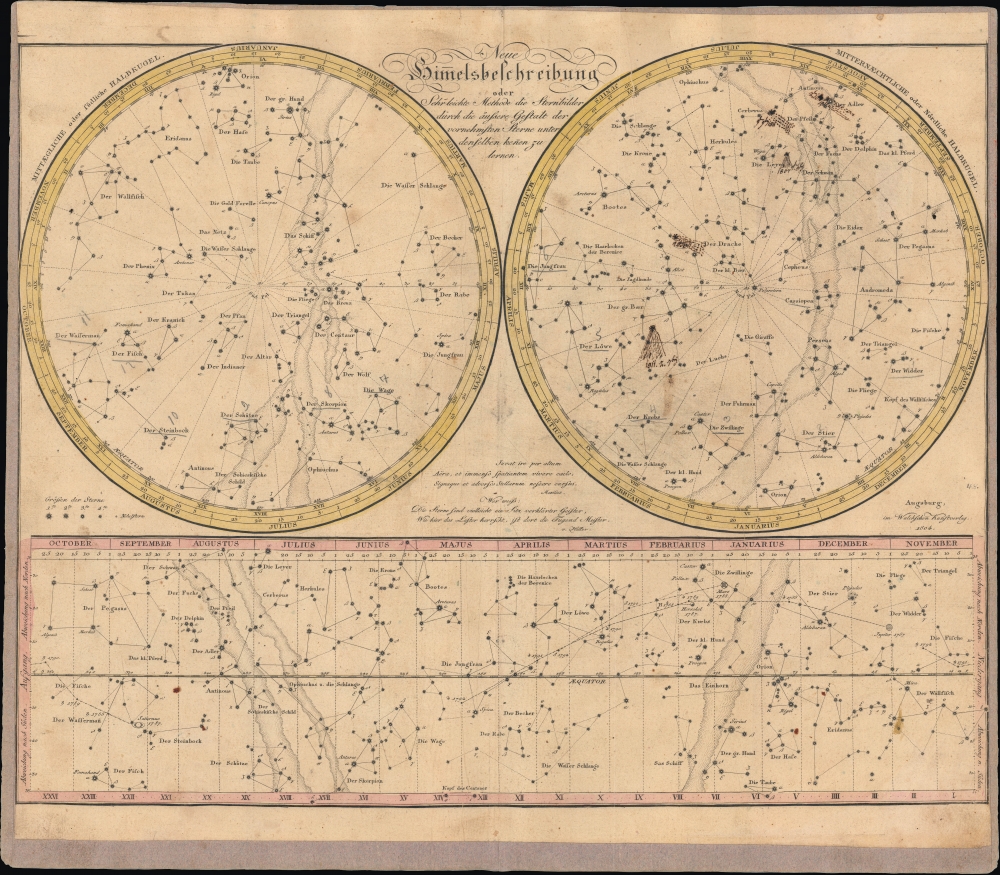1804 Walch Celestial Chart w/ Manuscript Record of Great Comet of 1811
CelestialChart-walch-1804
Title
1804 (dated) 18.5 x 23 in (46.99 x 58.42 cm)
Description
A Closer Look
The top part of the sheet contains a dual hemispheric depiction of the heavens, the 'midday' or northern hemisphere at left and the 'midnight' or southern hemisphere at right, with both hemispheres ringed by a border with the months of the year subdivided into sections. Constellations are labeled throughout in German or, in some cases, Latin, while the constellations' individual stars are labeled according to the Bayer system of classification. Stars, including nebula stars, are represented with symbols reflecting their size, as indicated in a small legend on the left. The hemispheres, particularly the right, contain significant manuscript annotations, including illustrations and dates of major comets, such as the Great Comet of 1811. Below the meeting point of the hemispheres are two quotes from poems, one by the ancient astronomer Marcus Manilius (c. 1st century CE) and the other by 18th-century naturalist Albrecht von Haller (1708 - 1777).The bottom portion of the sheet traces the seasonal deviation of the stars and also the recent (c. 1790s) movements of Mars, Jupiter, Saturn, and a body marked 'Herschel 1787.' This was perhaps one of the moons of Uranus (Oberon and Titania) discovered by German-British astronomer William Herschel that year, but more likely a reference to his earlier (1781) discovery of Uranus itself; the name of the new planet was not settled for decades and it was commonly referred to after its discoverer in these years. Herschel and his sister Caroline (1750-1848), who was his lifelong collaborator, pioneered many innovations in telescopy and astronomical spectroscopy that set off a period of improved astronomical observations.
Publication History and Census
This chart was prepared and published by Johannes Walch in Augsburg in 1804. Subsequent editions were published in 1820, 1826, 1833, and 1836, which, like the present edition, are quite scarce in institutional collections, especially outside of Germany. The only known institutional holding in North America is at Harvard University.Cartographer
Johannes Walch (November 25, 1757 - March 23, 1815) was a German painter, draftsman, engraver, cartographer and publisher. He was the son of abusinessman, amateur painter and engraver Sebastian Walch; he received training as a miniature painter in Augsburg, Geneva and the Vienna Art Academy. After a two-year trip to Italy, he settled in Augsburg, where he married the eldest daughter of the Augsburg-based engraver and publisher Johann Martin Will, and worked in his father-in-law's publishing house. His contributions led the publisher to focus more heavily on As a result, the publisher increasingly turned to map production, heavily supported by the acquisition of material from Lotter and Seutter. After Will's death in 1806, Walch inherited the firm and continued to increase its importance as a map publisher. His son Johann Sebastian Walch (1787–1840) would inherit the publishing house. More by this mapmaker...

